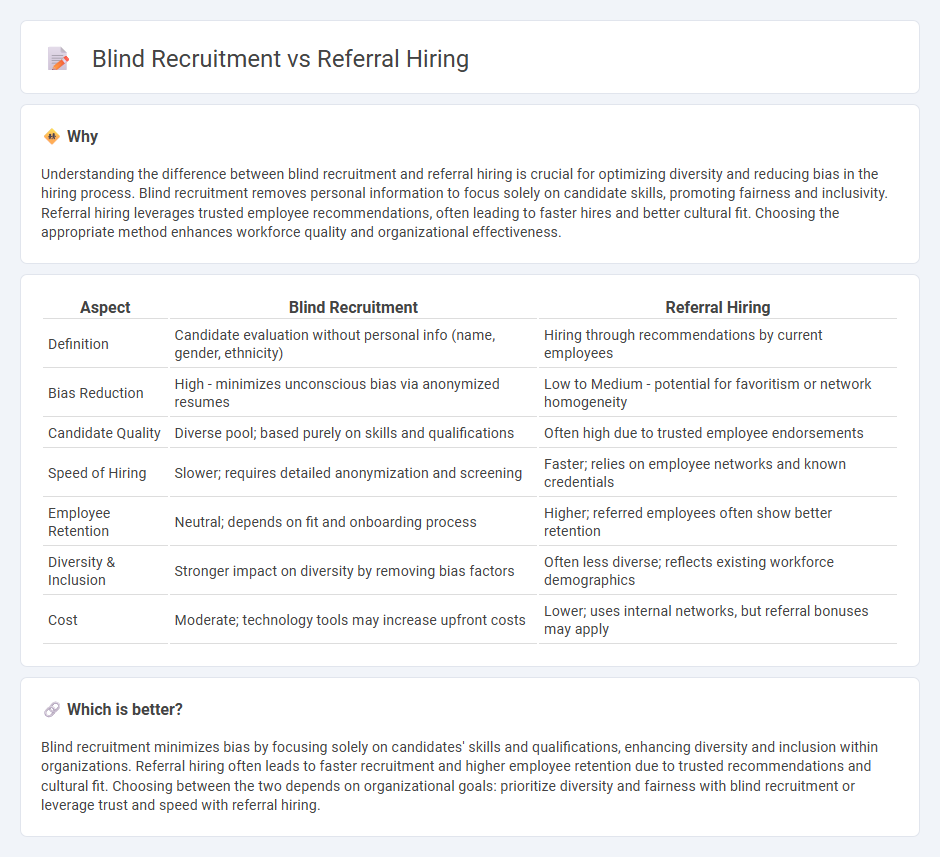
Blind recruitment minimizes unconscious bias by anonymizing candidate information such as names and demographics, focusing solely on skills and qualifications. Referral hiring leverages current employees' networks, often leading to faster hires and higher retention but may reinforce existing workplace homogeneity. Explore the advantages and challenges of these hiring methods to optimize your talent acquisition strategy.
Why it is important
Understanding the difference between blind recruitment and referral hiring is crucial for optimizing diversity and reducing bias in the hiring process. Blind recruitment removes personal information to focus solely on candidate skills, promoting fairness and inclusivity. Referral hiring leverages trusted employee recommendations, often leading to faster hires and better cultural fit. Choosing the appropriate method enhances workforce quality and organizational effectiveness.
Comparison Table
| Aspect | Blind Recruitment | Referral Hiring |
|---|---|---|
| Definition | Candidate evaluation without personal info (name, gender, ethnicity) | Hiring through recommendations by current employees |
| Bias Reduction | High - minimizes unconscious bias via anonymized resumes | Low to Medium - potential for favoritism or network homogeneity |
| Candidate Quality | Diverse pool; based purely on skills and qualifications | Often high due to trusted employee endorsements |
| Speed of Hiring | Slower; requires detailed anonymization and screening | Faster; relies on employee networks and known credentials |
| Employee Retention | Neutral; depends on fit and onboarding process | Higher; referred employees often show better retention |
| Diversity & Inclusion | Stronger impact on diversity by removing bias factors | Often less diverse; reflects existing workforce demographics |
| Cost | Moderate; technology tools may increase upfront costs | Lower; uses internal networks, but referral bonuses may apply |
Which is better?
Blind recruitment minimizes bias by focusing solely on candidates' skills and qualifications, enhancing diversity and inclusion within organizations. Referral hiring often leads to faster recruitment and higher employee retention due to trusted recommendations and cultural fit. Choosing between the two depends on organizational goals: prioritize diversity and fairness with blind recruitment or leverage trust and speed with referral hiring.
Connection
Blind recruitment enhances diversity and reduces bias by anonymizing candidate information, which complements referral hiring that leverages trusted employee recommendations to identify cultural fits. Combining blind recruitment with referral hiring balances objective skills assessment and insider insights, optimizing talent acquisition efficiency. This synergy helps organizations build inclusive teams while maintaining high-quality hires through trusted networks.
Key Terms
**Referral Hiring:**
Referral hiring leverages employee networks to identify qualified candidates, often resulting in faster recruitment and higher retention rates due to cultural fit. Studies show referred employees typically exhibit 25% higher productivity and stay 70% longer within organizations compared to non-referred hires. Discover more about how referral hiring can enhance your talent acquisition strategy.
Employee Networks
Employee networks in referral hiring leverage existing staff connections, enhancing candidate quality and cultural fit through trusted recommendations. Blind recruitment minimizes biases by anonymizing candidate information, promoting diversity and inclusion within the hiring process. Explore deeper insights on how employee networks impact referral hiring and diversity strategies.
Candidate Endorsement
Referral hiring leverages trusted employee recommendations to ensure candidate fit and cultural alignment, boosting retention rates by up to 45%. Blind recruitment omits personal details to minimize unconscious bias, emphasizing skill-based assessments for fairer candidate evaluation. Explore how candidate endorsement impacts hiring success and diversity strategies by learning more about these approaches.
Source and External Links
How To Refer Someone for a Job in 3 Steps (With Example) - Indeed - Referral hiring allows employees to recommend qualified candidates to save employers time and money, but it requires consideration of the candidate's qualifications and work ethic to avoid negative reflections on the referrer.
Employee Referrals: Definition, Common Benefits and Tips - Indeed - Employee referral programs enhance recruiting by encouraging employees to recommend candidates through clear communication of openings, promoting participation with incentives, and providing feedback to refine future referrals.
Want to Hire Top Talent? Here's How to Build an Employee Referral ... - BambooHR - Employee referral programs are highly effective for hiring quality candidates quickly and cost-effectively by leveraging trusted networks, increasing retention, and tapping passive job seekers.
 dowidth.com
dowidth.com